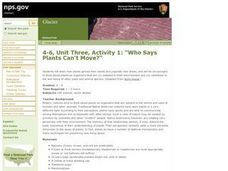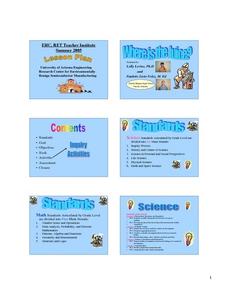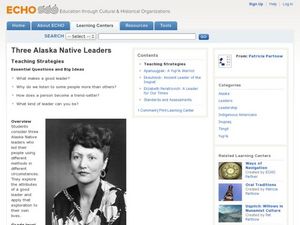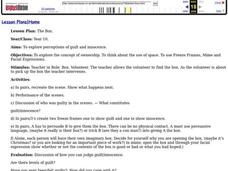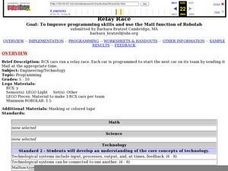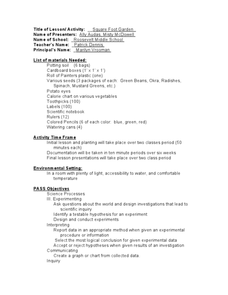Boston University
Scramble for Africa
For this fantastic simulation, your young historians take on the roles of imperialistic European countries in the nineteenth century and then "scramble" to carve up the continent of Africa! This is a very hands-on activity that will help...
National Center for Case Study Teaching in Science
To Boldly Go, or Not
Here is a different way to combine social studies and science. Have your high schoolers read a passage about the 2004 vision for space exploration and then discuss the practicality, costs, and reasons for returning to the moon. Then, the...
Curated OER
African American Literature in Art
Learners compare art and literature by examining a contemporary painting by Glenn Ligon and the essay by James Baldwin that inspired it. They write an essay about a personal experience that relates to the theme of being an "outsider."
Curated OER
Who Says Plants Can't Move?
Students discover how plants spread their seeds using other plants and animals. In this plant lesson, students role play different plants and how their seeds travel. Students then have a class discussion to ensure their understanding.
Curated OER
Hurricane Frequency and Intensity
Students examine hurricanes. In this web-based meteorology lesson, students study the relationship between ocean temperature and hurricane intensity. They differentiate between intensity and frequency of hurricanes.
Curated OER
The Energy Debate - Global Warming
Students describe what global warming is, what causes global warming and the impact to our world. They study the threat of global warming and its relationship to the use of fossil fuels.
Curated OER
2.0 "Water Is Life" Global Water Awareness Mini-Unit (Grades3-5)
Students study the amount of potable water on the Earth. In this water instructional activity, students examine the amount of potable water as compared to all the water on the Earth. They discuss why many parts of the world do not have...
Curated OER
Where Is The Juice?
Students are introduced to the component's of Ohm's Law. In groups, they practice their problem solving skills by reviewing problems solved earlier. They participate in activities that help them gather information on the importance of...
Workforce Solutions
Networking BINGO
A Networking BINGO game asks participants to find scholars who share a variety of the same interests and characteristics. Categories include everything from shoe size, to biggest fear, to intended college major.
BBC
Conflict
Middle schoolers take a close look at the different forms that bullying can take, and share their ideas of ways to stop bullying in schools. Learners get together in groups of three and come up with a scenario that depicts a...
Curated OER
Ohio Statehouse History
Fourth graders examine the history of the Ohio Statehouse and order the major historical events in its development. The lesson traces the development from the time of Ohio's vast wilderness to the house's completion in 1861.
Curated OER
Diversity Day
Eleventh graders explore a variety of different cultures and their traditions. They complete an evaluation and short reflection of the day on the following prompts: I learned I... and I wish I... Each student then observes and talks with...
Curated OER
Introduction to Drama
Introduce your class to drama! You cast each pupil as a different character from a story you have read. They are given a general outline of the scene, act out the scene multiple times, then discuss the weak and strong aspects of each...
Curated OER
Three Alaska Native Leaders
Students discover the contributions of 3 Alaskan leaders. In this Alaska history lesson, students research the leaders Nathaniel Bowditch, Ki'ianaa'ahu'ula, and Elizabeth Peratrovich. Students present their findings through drama and...
Curated OER
Who's in the News Bulletin Board
Students are introduced to current events through the use of a class bulletin board. They choose a person from current events to study and follow an outline to produce one or two notecards of information. They present their information...
Curated OER
Personal History
Fourth graders gain an appreciation of knowledge about recent history by interviewing senior citizens. They summarize their interviews and organize them into a written presentation.
Curated OER
Infusing Equity By Gender Into the Classroom:
Young scholars analyze personal perception of gender role assignments. They complete their "personal" point of view, then complete the "societal" view as a group.
Curated OER
Parallel Lives
Young scholars research the life of an important person in the Civil War on each side who had basically the same responsibilities. They create a timeline based on their lives and present their findings to the class.
Curated OER
The Box
Tenth graders identify and interpret the perceptions of guilt and innocence. Then they explore the concept of ownership and think about the use of space as it relates to these terms. Students also use Freeze Frames, Mime and Facial...
Curated OER
Internment of Japanese Americans
Students study the Japanese-American experience in the western United States during World War II. They view a video, "Japanese Relocation" and take notes on arguments in favor of internment. They share their notes and new vocabulary...
Curated OER
Relay Race
Students program RCX cars to relay information to one another via Mail when triggered by light sensors. The light sensors are appropriately spaced to allow for timed triggers.
Curated OER
Pottery Analysis
Students study how archaeologists analyze artifacts to answer questions about past cultures. They explain why pottery is important to archaeologists and how they use classification to answer their research questions.
Curated OER
Trappers Then and Now
Students study how trapping in the Illinois Territory in the 1800's effected the beaver population in the state. They compare methods, rules and regulations of the 1800s to those of today. In groups, they research a variety of...
Curated OER
Square Foot Garden
Students plant a garden and keep track of it. In this geometrical garden lesson, students collect data from their garden twice a week. They graph their finding and figure out how many square feet of growing space each person needs...





